Enhancing Hand Hygiene Practices Among Young Nurses
Introduction
The process of handwashing is an essential part of the daily routine of life. It is also important to prevent the infectious spread and thus to help in preventing illness (Staats, 2017). It also further helps in preventing the spread of various communicable diseases from one patient to another (Vermeil, 2019). Therefore, the inclusion of a good hand hygiene practice can play a vital role in potentially decreasing the spread of different types of infections from one patient to another. If nurses follow the practice of hand hygiene, they can prevent themselves from catching an infection and help contain the spread to the patient. However, young nurses might lack the education required to follow strict hand hygiene guidelines and protocols, including handwashing in their daily routine (Ahmed et al. 2020). Therefore, educational strategies are required to help these young nurses to have a good idea of the importance of hand hygiene in nursing practice (Lydon, 2017). For those working on a nursing dissertation, seeking nursing dissertation help can offer valuable insights into designing effective educational strategies.
This assignment will present a discussion on how adult nurses can be advised and guided in following and implementing the necessary strategies of hand hygiene. In this context, this assignment will first use the PIO tool for formulating the relevant research question regarding the selected research topic. Then this assignment will discuss the research methodology by discussing the search strategy, keywords and Boolean operators that are used to collect the relevant research articles on the selected research topic. Then the assignment will present the critical analysis and discussion. Finally, this assignment will present a conclusion in which the main aspects of their research project will be discussed.

Literature search:
PIO [problem, intervention and outcome] framework is widely used in academic research to formulate well-focused research questions on the research topic (Etikan et al., 2016). Here researcher used PIO tools for forming the highly appropriate and well-constructed research questions by analyzing the three major aspects such as patients, the clinical intervention of maintaining proper hand hygiene by nurses and the outcomes of hand hygiene. By using the PIO tool following research question is formed:
"What is the role of education in nurses to educate about hand hygiene compliance and improve patient safety?"
PIO Framework

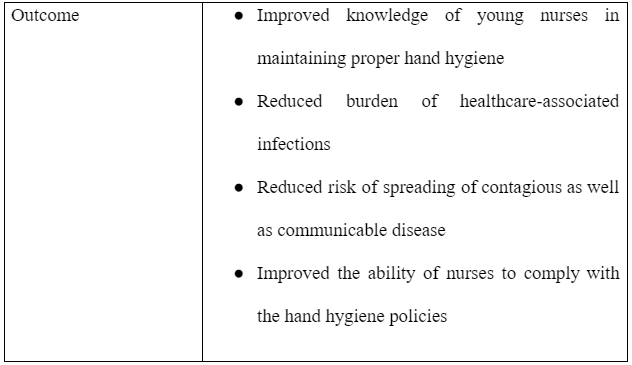
Search strategy:
A search strategy is the crucial aspect of any academic research, that enables the researcher to collect the relevant and authentic database on the selected research topic to meet the research objectives (Thielen et al. 2016). In this research, the project researcher conducted secondary research by collecting and retrieving the appropriate and relevant online research articles on the research topic. the researcher used relevant online databases such as CINAHL, PubMed, Psych Info, British national Index, MEDLINE, google scholar and Cochrane in terms of searching for the relevant research articles (Rahi, 2017). While searching for these research papers, it was seen that the search result obtained by using BNI had several duplicated research papers therefore the search results by using BNI had been removed. keywords and Boolean operators (OR, AND, NOT) are used to expand or narrow the literature search thereby collecting the relevant research articles in the selected research topic (Palinkas et al., 2015).
Keywords:
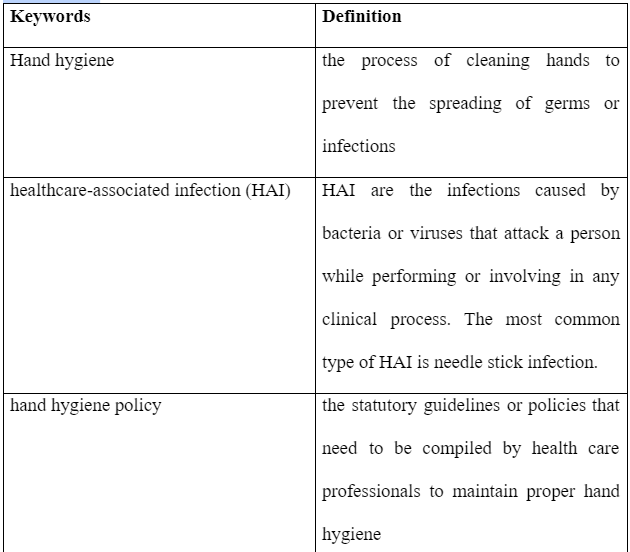

Inclusion and exclusion criteria:
Inclusion and exclusion criteria are the predefined characteristics that are used to select research papers that are highly authentic and relevant to the selected research topic. here researcher used the following conclusion and exclusion criteria:
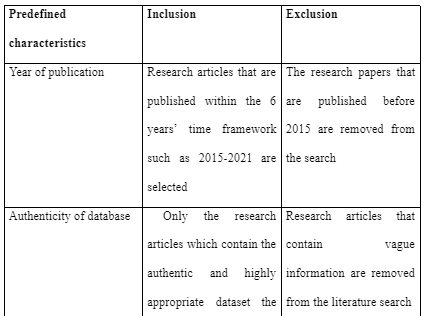
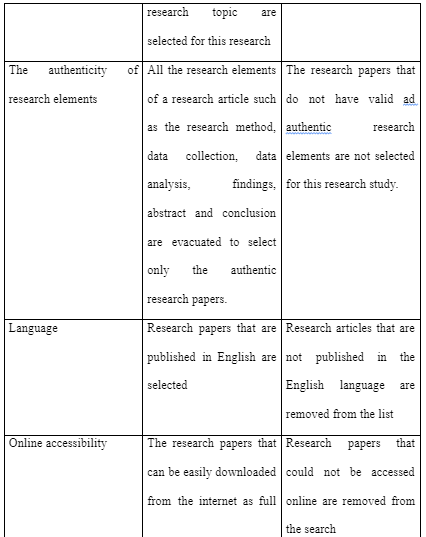

With the help of a methodical and step-wise approach, relevant studies relating to the keywords and the focus question were extracted for the analysis purpose. Another commonly used Boolean operator was considered for this analysis. This was done with the help of the use of the "AND" operator (Kruse, 2017). This helped in connecting two words and inserting them in the same search category. This helped in narrowing down the search. This was fruitful in connecting some of the important terms such as "nursing professionals", "healthcare professionals", "education strategies", "educational interventions", "improved clinical management", "improved clinical outcomes", "adherence", "and compliance" and so on. It was also focused that all articles that were considered for the analysis were in the English language. This was done as per academic integrity standards (Long et al., 2020.). All of the studies which were published between the year range of 2015-2021 were considered for the evaluation purpose (Javadi and Zarea, 2016). It was also made sure that all of the articles were peer-reviewed.
Selection of literature
Multiple resonating records were analyzed, and approximately 100 articles were considered after the primary search. From these studies, an additional number of about 80 duplicate records were removed. The remaining 20 articles were judged based on the abstract of the study. This helped in checking the articles for meeting the inclusion and exclusion criteria for the evaluation. [refers to Prisma diagram in appendix1]
Further filter was applied to select all of the full-text articles so that meta-analysis of the details can be scanned thoroughly. Out of these defined results, the articles based on qualitative and quantitative research method approaches were further bifurcated. The two studies from each category were considered based on inclusion criteria. The selected quantitative research was Trannin, K.P.P., Campanharo, C.R.V., Lopes, M.C.B.T., Okuno, M.F.P. and Batista, R.E.A., (2016). Adherence to hand hygiene: intervention and assessment, and the selected qualitative research study were Kaur, R., Razee, H. and Seale, H. (2016) 'Development and appraisal of a hand hygiene teaching approach for medical students: a qualitative study, Journal of Infection Prevention. These two studies met with the defined specification and the main framework of the focused question.
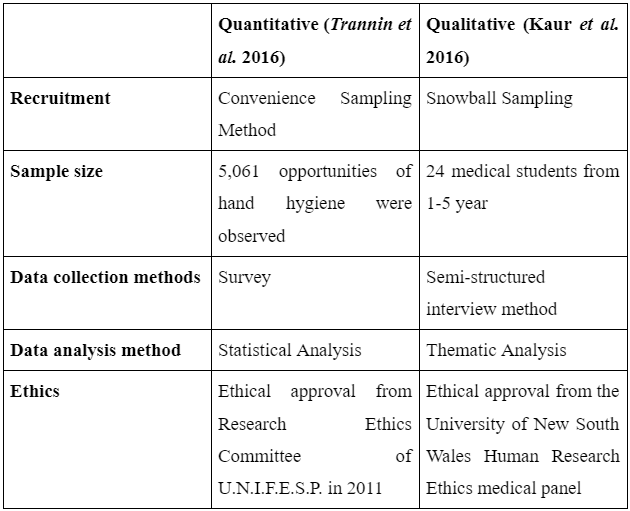
Critique of the qualitative study:
The CASP tool mentions determining if the aim of the study is clear and if the chosen methodology for the study is appropriate in appraising the study (CASP, 2018). In the study by Kaur et al. (2016), a clarified aim is present which is important as it helps the readers to determine the focus of the study and relate its usefulness to be included in fulfilling the chosen topic for analysis (Doody and Bailey, 2016). The study by Kaur et al. (2016) used qualitative research methodology in gathering information for the study. The chosen methodology is advantageous for the study because qualitative analysis helped in gathering detailed personal views, feelings and attitude regarding the topic of discussion which assist in critical understanding of the facts to effectively resolve the raised research question (Collins and Stockton, 2018). The methodology is appropriate as it helped in gathering detailed feedback on the importance of hand hygiene teaching and its usefulness in practice among the nurses which is the key focus of the study.
The use of purposeful and snowball sampling is important for the study because it allows discovering characteristic regarding a population that the researchers are unaware to exist, in turn, helping to conduct the study in reliable way by inclusion of effective participants (Ghaljaie et al., 2017). However, using snowball sampling may have raised bias in selection of participants and raised issue regarding the representativeness of results gathered from them (Anieting and Mosugu, 2017). The interview was appropriate data collection process as it helped in gathering descriptive feedback from participants and their feeling as well as attitude regarding the study topic essential in analysis of results (Skelton et al., 2020). The format opted for the interview method was a semi-structured method (Palinkas, 2015). As it is an open-ended method of data collection, it helped explore the participant's more profound thoughts and feelings in any given instance. As per the considered topic of evaluation, it is quite essential to have an in-depth analysis of the same. This will help formulate participant-specific intervention for data collection.
The researcher can be observed to take frequent feedback from the study participants. The researcher is not observed to modulate the behaviour of the participant, so there are reduced chances of bias in the study. The data collected with the feedback has been used for comparative analysis only. Each participant has provided consent before participating in the study. Due to ethical approval from the University of New South Wales Human Research Ethics medical panel, the researcher has taken. Therefore, the study has followed all ethical and legal compliance before commencing with the study methods.
All of the data collected with the help of the group interview were analysed thematically. The collected data was in the form of audios and field notes. The thematic analysis helped find a significant correlation between the various datasets analysed for the study purpose (Javadi, 2016). This further helped significantly express the themes transcribed as per the coding and evaluation through thematic analysis. The results were not declared collectively, instead of in an individual manner. A total number of eight groups were defined between a total number of 24 students. This helped in exploring the defined teaching methods concerning individual opinion rather than group opinion as well. The roles of various activities used were helpful in potentially increasing the knowledge of hand hygiene practice. However, the results were only discovered on a short-term basis, and thus, there is the future scope of analysing a set pattern. This pattern has to be evaluated concerning the positive outcomes of various educational strategies used for medical students to improve hand hygiene practices compliance further. The study contributed to the need for changes to be made in the current educational standards and practices. This is vital to highlight the essential role of hand hygiene in clinical practice daily.
Critique of the Quantitative Study
According to the CASP tool, the aim of the study is to be clarified (CASP, 2018). This is because aim mentions the brief knowledge and understanding to be gathered by analysis of the specific study and its validity in exploring topic of interest by the reader (Clegg and de Matos, 2017). In the study by Trannin et al. (2016), the aim is clearly mentioned which is observing the level of adherence to hand hygiene by health professionals in emergency care unit.
The CASP tool mentions to determine if the methodology used is appropriate in the study for effectively analysing the study (CASP, 2018). In the study by Trannin et al. (2016), the quantitative methodology is used. This is appropriate because by counting through observation the number of chances the hand hygiene is adhered by health professionals would help in determining the efficiency of their ability to follow the action and level of impact of the educational intervention regarding hand hygiene organised within the organisation between July 2012 and December 2013. According to CASP tool, the way participants are recruited, and data collection process is to be mentioned in detail and required to be related with the aim of the study (Carpenter and Glasper, 2021). In the study of Trannin et al. (2016), no direct participants are included, and data is gathered based on chances of adherence to hand hygiene by health professional. The lack of real-life participants acts as limitation for the study because the number of health professionals adhered to the hand hygiene could not be determined and observation may lead to assess the adherence level of the hand hygiene in duplicated manner which would raise bias in data collection.
The data is collected by using the convenience sampling method. This type of sampling can be most effective to promote the ease of research. The data can be collected for any population group with this method of sampling (Etikan, 2016). It is also a relatively cost-effective and robust method for collecting abstract data. As the study was based on evaluating a pattern of hand hygiene adherence, this sampling method can be the best possible and flexible choice for data collection. The collection of data was also bifurcated into pre and post-intervention periods. This helped in enabling a comparative analysis of the results obtained from the study.
The researcher himself completed the form and other details, and thus, he was in close coordination with the study participants. However, as the study was primarily based on analysing the observatory pattern, there was no one-on-one interaction between the study participants and researchers. The CASP tool mention to determine if ethics in the study is appropriately ensured (CASP, 2018). This is important as ethical studies ensure the researcher have morally and legally conducted the research without causing any harm to the participants, in turn assuring valid execution of the study along with its credibility (Schuklenk, 2017). The study by Trannin et al. (2016) was approved by the Research Ethics Committee of U.N.I.F.E.S.P. in 2011 which ensures it was ethically correct and adequate. The study ensured to keep the identity of all patients undercover, and the same was not revealed during any point of the study process. The study compared the categorical variables which were independent of each other.
For finally evaluating the data, chi-square and ANOVA tests were used. This helped find a significant relationship between the level of significance between the interventions and groups considered for evaluation (Olanipekun, 2015). This method helped describe the significance level by interlinking the variables with the participants and the intervention considered. The results and key findings were presented in a compatible manner with the help of comparative analysis. Observing the opportunities helped identify the key factors impacting adherence and non-adherence in the subject population. The CASP tool mentions to determine if the study findings are effectively informed (Long et al., 2020). This is important as detailed study findings helps in gathering evidence to be used as support for real-life care practice.
The study results were detailed and helpful in enabling a fruitful and positive insight into various optimal teaching and educational strategies to further strengthen hand hygiene compliance. As the study subjects showed an increased adherence to hand hygiene after implementing educational interventions, the same can be used for future clinical practices. The study was also able to shift the focus on other related factors associated with hand hygiene. This included improved quality of care, patient safety promotion and reduced hospital costs with the reduced transmission of infectious spread.
Discussion
The study conducted by Trannin et al. (2016) was not only able to highlight the importance of hand hygiene but was also able to promote adherence to the same. The study also included a more significant number of opportunities, which helped evaluate a set pattern of hand hygiene in healthcare professionals. The main strength of the study was that the healthcare department opted for analysis purposes. The study was based on examining hand hygiene practice in the emergency department, which can be considered a potential source of infectious spread (Trannin, 2016). The study also highlighted the adherence and continuation of educational strategies for promoting hand hygiene practice in a healthcare setting. However, the study's main limitation was not highlighting the data on the technique of hand hygiene used by healthcare workers in the emergency department.

On the other hand, the study conducted by Kaur et al. (2016) helped highlight upon drawing the focus of medical students towards hand hygiene practice. The study helped in gaining favourable feedbacks from the analysis. The study was also able to focus importance on the suggestion of inclusion of activities for potentially increasing the knowledge of hand hygiene in medical students (Kaur, 2016). It was also able to show how these strategies could reduce the incidences of infectious spread in healthcare settings. The main limitation of this study was observed in terms of restriction of data collected from only one potential source. The study was based on an analysis of medical students from a single medical school. Thus, restricting the researcher to explore the pattern of non-adherence to hand hygiene in a healthcare setting. The study also failed to check with the medical students for their respective knowledge of the subject matter and their respective approaches towards hand hygiene practice. The study also reflected on the overall challenge of engaging medical students in the robust practice of hand hygiene and encouraging them for educational strategies.
Overall, the quantitative study results showed a positive inclination of nurses towards hand hygiene after getting proper educational interventions. The adherence towards hand hygiene was also found to have been improved in these subjects. However, the qualitative study highlighted the importance of the topic of hand hygiene and how this subject is quite underestimated. Therefore, there is a higher need to better approach various educational strategies to fill these educational gaps. The same will help improve the reduced incidence of infectious spread. Therefore, helping to improve patient safety and enabling improved healthcare outcomes for the patients.
Conclusion:
From the above-mentioned discussion, it can be concluded that Hand Hygiene (HH) is crucial in healthcare to promote the positive health and wellbeing of services providers and service users. Education to medical staff on how to maintain proper HH practices is important which will not only enable them to avoid the risk of any healthcare-associated infection during the professional practices but also maintain a high level of patient’s safety. Additionally, through using the modern teaching adhering techniques, medical staff can be educated easily regarding how to comply with all the HH policies to maintain workplace safety and hygiene. This education to medical staff will also improve their understanding regarding the factors that can interfere with the ability of healthcare professionals to comply with the HH policies.
References
ADAMS, J., HILLIER-BROWN, F.C., MOORE, H.J., LAKE, A.A., ARAUJO-SOARES, V., WHITE, M. and SUMMERBELL, C., 2016. Searching and synthesising 'grey literature and 'grey information in public health: critical reflections on three case studies. Systematic Reviews, 5(1), pp.1-11. https://doi.org/10.1186/s13643-016-0337-y
AHMED J., MALIK, F., MEMON, Z.A., ARIF, T.B., ALI, A., NASIM, S., AHMAD, J. and KHAN, M.A., 2020. Compliance and knowledge of healthcare workers regarding hand hygiene and use of disinfectants: a study based in Karachi. Cureus, 12(2).
ALSHAMMARI, M., REYNOLDS, K.A., VERHOUGSTRAETE, M. and O’ROURKE, M.K., 2018, December. Comparison of perceived and observed hand hygiene compliance in healthcare workers in MERS-CoV endemic regions. In Healthcare (Vol. 6, No. 4, p. 122). Multidisciplinary Digital Publishing Institute.
BISWAL, M., ANGRUP, A., RAJPOOT, S., KAUR, R., KAUR, K., KAUR, H., DHALIWAL, N., ARORA, P. and GUPTA, A.K., 2020. Hand hygiene compliance of patients' family members in India: the importance of educating the unofficial 'fourth category’of healthcare personnel. Journal of Hospital Infection, 104(4), pp.425-429.
BLOOMFIELD, J. and FISHER, M.J., 2019. Quantitative research design. Journal of the Australasian Rehabilitation Nurses Association, 22(2), pp.27-30. https://search.informit.org/doi/abs/10.3316/INFORMIT.738299924514584
BRAMER, W.M., RETHLEFSEN, M.L., KLEIJNEN, J. and FRANCO, O.H., 2017. Optimal database combinations for literature searches in systematic reviews: a prospective exploratory study. Systematic Reviews, 6(1), pp.1-12. https://doi.org/10.1186/s13643-017-0644-y
CHEN, J.K., WU, K.S., LEE, S.S.J., LIN, H.S., TSAI, H.C., LI, C.H., CHAO, H.L., CHOU, H.C., CHEN, Y.J., HUANG, Y.H. and KE, C.M., 2016. Impact of implementing the World Health Organization multimodal hand hygiene improvement strategy in a teaching hospital in Taiwan. American Journal of Infection Control, 44(2), pp.222-227. https://doi.org/10.1016/j.ajic.2015.10.004
ETIKAN, I., MUSA, S.A. and ALKASSIM, R.S., 2016. Comparison of convenience sampling and purposive sampling. American Journal of Theoretical and Applied Statistics, 5(1), pp.1-4. 10.11648/j.ajtas.20160501.11
HADAWAY, A., 2020. Handwashing: clean hands save lives. Journal of Consumer Health on the Internet, 24(1), pp.43-49.
JAVADI, M. and ZAREA, K., 2016. Understanding thematic analysis and its pitfall. Demo, 1(1), pp.33-39. http://dx.doi.org/10.15412/J.JCC.02010107
KAUR, R., RAZEE, H. and SEALE, H. (2016) 'Development and appraisal of a hand hygiene teaching approach for medical students: a qualitative study, Journal of Infection Prevention, 17(4), pp. 162–168. 10.1177/1757177416645345.
KRUSE, C.S., FREDERICK, B., JACOBSON, T. and MONTICONE, D.K., 2017. Cybersecurity in healthcare: A systematic review of modern threats and trends. Technology and Health Care, 25(1), pp.1-10. 10.3233/THC-161263
LYDON, S., POWER, M., MCSHARRY, J., BYRNE, M., MADDEN, C., SQUIRES, J.E. and O'CONNOR, P., 2017. Interventions to improve hand hygiene compliance in the I.C.U.: a systematic review. Critical Care Medicine, 45(11), pp.1165-1172. https://doi.org/10.1097/CCM.0000000000002691
PALINKAS, L.A., HORWITZ, S.M., GREEN, C.A., WISDOM, J.P., DUAN, N. and HOAGWOOD, K., 2015. Purposeful sampling for qualitative data collection and analysis in mixed method implementation research. Administration and Policy in Mental Health and Mental Health Services Research, 42(5), pp.533-544. https://doi.org/10.1007/s10488-013-0528-y
RAHI, S., 2017. Research design and methods: A systematic review of research paradigms, sampling issues and instruments development. International Journal of Economics & Management Sciences, 6(2), pp.1-5. 10.4172/2162-6359.1000403
RIDLEY, N., 2020. Effective hand hygiene—wash your hands and reduce the risk. British Journal of Nursing, 29(1), pp.10-10.
SAITOH, A., SATO, K., MAGARA, Y., OSAKI, K., NARITA, K., SHIOIRI, K., FOWLER, K.E., RATZ, D. and SAINT, S., 2020. Improving hand hygiene adherence in healthcare workers before patient contact: a multimodal intervention in four tertiary care hospitals in Japan. J Hosp Med, 15(5), pp.262-267.
STAATS, B.R., DAI, H., HOFMANN, D. and MILKMAN, K.L., 2017. Motivating process compliance through individual electronic monitoring: An empirical examination of hand hygiene in healthcare. Management Science, 63(5), pp.1563-1585. https://doi.org/10.1287/mnsc.2015.2400
THIELEN, F.W., VAN MASTRIGT, G.A.P.G., BURGERS, L.T., BRAMER, W.M., MAJOIE, H.J.M., EVERS, S.M.A.A. and KLEIJNEN, J., 2016. How to prepare a systematic review of economic evaluations for clinical practise guidelines: database selection and search strategy development (part 2/3). Expert Review of Pharmacoeconomics & Outcomes Research, 16(6), pp.705-721. https://doi.org/10.1080/14737167.2016.1246962
TRANNIN, K.P.P., CAMPANHARO, C.R.V., LOPES, M.C.B.T., OKUNO, M.F.P. and BATISTA, R.E.A., 2016. Adherence to hand hygiene: intervention and assessment. Cogitare Enferm, 21(2), pp.1-7. https://docs.bvsalud.org/biblioref/2016/07/640/44246-178126-1-pb.pdf
VERMEIL, T., PETERS, A., KILPATRICK, C., PIRES, D., ALLEGRANZI, B. and PITTET, D., 2019. Hand hygiene in hospitals: anatomy of a revolution. Journal of Hospital Infection, 101(4), pp.383-392. https://doi.org/10.1016/j.jhin.2018.09.003
VILLARREAL, S.E.M., KHAN, S., ODUWOLE, M., SUTANTO, E., VLECK, K., KATZ, M. and GREENOUGH, W.B., 2020. Can educational speech intervention improve visitors' hand hygiene compliance?. Journal of Hospital Infection, 104(4), pp.414-418.
Appendix:
PRISMA tool
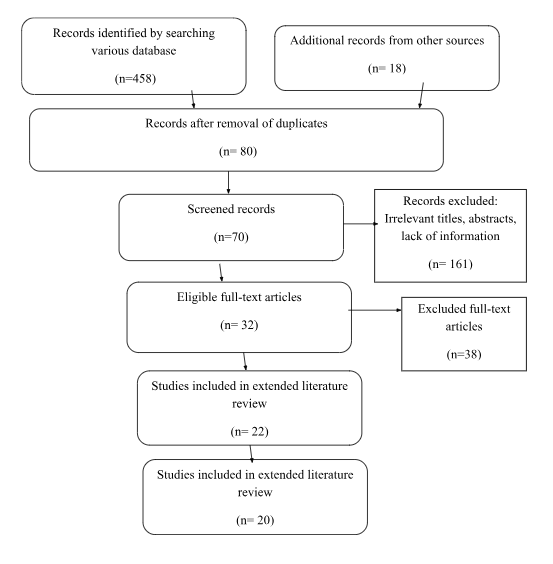
Continue your journey with our comprehensive guide to Empowering Healthcare Through Compassionate Leadership.
What Makes Us Unique
- 24/7 Customer Support
- 100% Customer Satisfaction
- No Privacy Violation
- Quick Services
- Subject Experts



